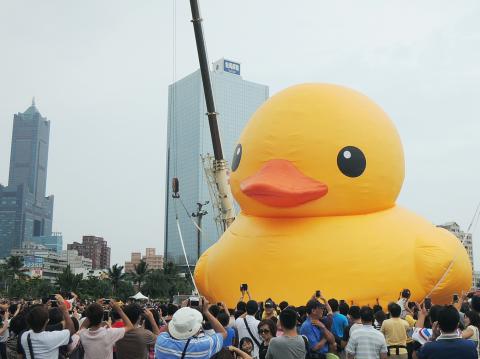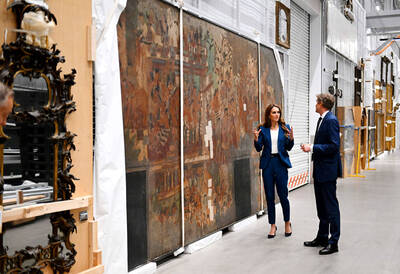Kriston Capps is an American art critic in Washington, DC, and while he did not visit Taiwan to witness the harbor tours of Dutch artist Florentijn Hofman, he read enough about the public art brouhaha over the now infamous “big yellow duck” as to become a bit incredulous.
Was the inflatable Rubber Duck “public art” or mere tourist marketing which outsourced the creative work to a non-Taiwanese artist overseas when surely there were local artists who would have loved some commissions by city and harbor officials?
Capps, in an article published in September in CityLab, an online urban arts magazine, didn’t waste any time inflating the rubber duck tour. Headlined The ‘rubber duck’ artist must be stopped, he said that the “Rubber Duck sends an infantilizing message about the role of public art in cities.”

Photo: Wang Rong-hsiang, Taipei Times
PUBLIC ART OR ASTUTE MARKETING
As for the infamous rubber duck — “designed” by Hofman to be an oversized version of a popular bath toy first created and patented in 1947 by a Los Angeles sculptor — not everyone in Taiwan considered it to be public art by any means and wondered what the fuss was all about.
For Taiwanese film director Huang Ming-chuan (黃明川), who has made a series of well-received video documentaries about local artists, the yellow duck tour was full of holes.
“Taiwanese politicians believed this European cute duck could attract voters’ attention,” Huang said. “That was the core thinking ... and not about art or public art.”
The arrival of Hofman’s duck sent local media into a frenzy of pointless reporting over how “cute” the huge bath creature was.
Hofman’s Web site says it all, in a kind of New Agey way: “The Rubber Duck knows no frontiers, it doesn’t discriminate [against] people and doesn’t have a political connotation ... has healing properties ... and is suitable for all ages.”
So were tourism officials in Greater Kaohsiung and Keelung taken in while also cashing in with the duck “events?” And by doing so, were they inadvertently “outsourcing” a public art project to an overseas artist and neglecting local Taiwanese artists who could use the gigs?
Lin Su-chun (林素純), a Taipei resident who is doctoral candidate in philosophy at National Cheng Kung University, said that the rubber duck was “commercialized and hyped by the media, to the point of overkill,” Lin said, adding that she doesn’t see the duck as art, public or otherwise.
“But ... if we are talking about local city tourism or sightseeing in Taiwan, I felt that the rubber duck was a very impressive landmark.”

June 9 to June 15 A photo of two men riding trendy high-wheel Penny-Farthing bicycles past a Qing Dynasty gate aptly captures the essence of Taipei in 1897 — a newly colonized city on the cusp of great change. The Japanese began making significant modifications to the cityscape in 1899, tearing down Qing-era structures, widening boulevards and installing Western-style infrastructure and buildings. The photographer, Minosuke Imamura, only spent a year in Taiwan as a cartographer for the governor-general’s office, but he left behind a treasure trove of 130 images showing life at the onset of Japanese rule, spanning July 1897 to

One of the most important gripes that Taiwanese have about the Democratic Progressive Party (DPP) is that it has failed to deliver concretely on higher wages, housing prices and other bread-and-butter issues. The parallel complaint is that the DPP cares only about glamor issues, such as removing markers of Chinese Nationalist Party (KMT) colonialism by renaming them, or what the KMT codes as “de-Sinification.” Once again, as a critical election looms, the DPP is presenting evidence for that charge. The KMT was quick to jump on the recent proposal of the Ministry of the Interior (MOI) to rename roads that symbolize

On the evening of June 1, Control Yuan Secretary-General Lee Chun-yi (李俊俋) apologized and resigned in disgrace. His crime was instructing his driver to use a Control Yuan vehicle to transport his dog to a pet grooming salon. The Control Yuan is the government branch that investigates, audits and impeaches government officials for, among other things, misuse of government funds, so his misuse of a government vehicle was highly inappropriate. If this story were told to anyone living in the golden era of swaggering gangsters, flashy nouveau riche businessmen, and corrupt “black gold” politics of the 1980s and 1990s, they would have laughed.

Imagine being able to visit a museum and examine up close thousand-year-old pottery, revel alone in jewelry from centuries past, or peer inside a Versace bag. Now London’s V&A has launched a revolutionary new exhibition space, where visitors can choose from some 250,000 objects, order something they want to spend time looking at and have it delivered to a room for a private viewing. Most museums have thousands of precious and historic items hidden away in their stores, which the public never gets to see or enjoy. But the V&A Storehouse, which opened on May 31 in a converted warehouse, has come up